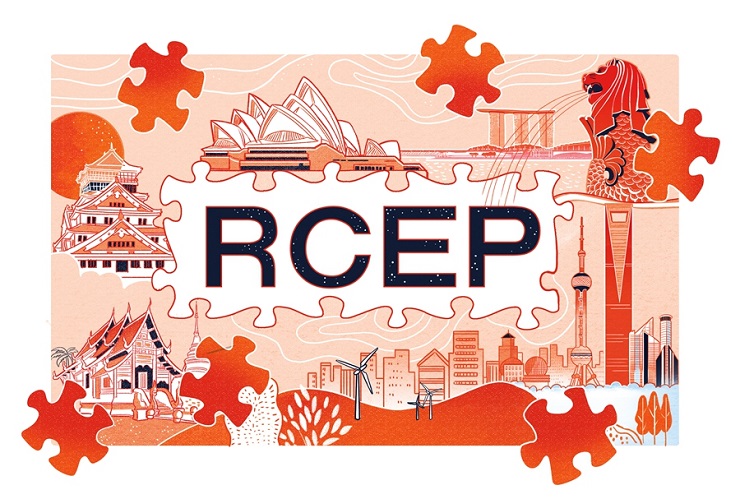Even though the Biden administration, following in the footsteps of the Trump administration, has been seeking to build a global anti-China coalition even since coming into power, its efforts in the Indo-Pacific region continue to fail to produce enough support for the US-led ‘war’ against China. To a large extent, a key reason for this failure to garner enough support is not only the fact that the US does not have any economic programme to back up its military rhetoric, but also because China’s meteoric rise has given the Indo-Pacific region a trade partner they cannot dispense with. China’s central position in the region – in particular, the region that encompasses the Regional Comprehensive Economic Partnership (RCEP) – is inevitable for the RCEP’s own economic growth – an undeniable fact that leaves Washington’s aggressive anti-China rhetoric meaningless. Figures speak for themselves: China’s trade with RCEP members surged by 3.5 percent to 10.2 trillion yuan in 2020, according to the data shared by China’s customs. This trade volume represents a third of China’s global trade volume.
China, in other worlds, is already much more and deeply integrated with the RCEP countries than the US policy of disentanglement can hope. This integration is not unilateral. As the data show, exports to China from the rest of Asia rose by 260% between 2016 and 2021. This figure is the biggest margin of trade expansion in any major market. With the RCEP now fully ratified and operational since the first day of 2022, multilateralism is likely to grow further – a growth that will proportionately reduce the US ability to manipulate the region to its advantage.
There are already fears in Washington. In November last year, members of the US Senate Finance Committee wrote a letter to Biden to highlight how the US was losing to China. They argued:
“China is quickly seizing the initiative for trade policy in the East—to the detriment of United States interests. Fifteen countries—comprising 30 percent of global Gross Domestic Product—have signed on to a trade deal that China backs: the Regional Comprehensive Economic Partnership (RCEP), an agreement that comports with China’s interests, including weak rules on intellectual property rights, and none whatsoever on state-owned enterprises. Meanwhile, while the United States continues to disparage the Comprehensive and Progressive Transpacific Partnership (CP-TPP), the agreement that it helped negotiate, China now wants to join it.”
If left “unanswered”, the letter further agues, the US will be in a “strategically unfavourable position”, as China will be able to “displace the United States from its pre-eminent position in international affairs.”
Given the fact the US does not have any viable economic and trade framework, the US lacks any tools vis-à-vis China to prevent the Senators’ fears from coming true. In fact, the Biden administration is, as some US media reports have highlighted, actually struggling to put forward any plan of economic engagement with Asia.
While the Obama administration was sensitive to the issue, as it negotiated the ambitious Trans-Pacific Partnership (TPP) that even included seven RCEP members, the Trump administration’s cancellation of the TPP plus its multiplate ‘trade wars’ with many partner US countries have left the Biden administration with minimum options to undo the Trump administration’s phenomenal success in making trade with the US a particularly toxic issue. While most of the TPP members decided to redesign the pact as CPTPP without the US, it is the RCEP that has, for now, overtaken the region. China, sensing how the pact could deliver immense benefits, is keen to operationalise it fully.
As it stands, ever since the RCEP’s operationalisation, the China Council for the Promotion of International Trade (CCPIT) had issued 275 RCEP certificates of origin for 135 Chinese enterprises from 18 provinces and municipalities. These certificates have been issued to lower tariff payments as part of the RCEP deal. Overall, the deal will eventually eliminate more than 90% of tariffs on commerce among its 15 member countries. Lowering of tariff prices is one key dimensions of the whole RCEP project.
The deal covers 2.3 billion people. This is over 30 per cent of the world’s total population. It is expected to contribute US$ 25.8 trillion – which is about 30 per cent of global GDP – to the world economy. It is accounts for over a quarter (US$ 12.7 trillion) of global trade in goods and services. In terms of Foreign Direct Investment, the RCEP accounts for 31 per cent of global FDI inflows. The RCEP is, thus, not simply a pact of trade; it is a new geography of economics which leaves bi-lateral conflicts and issues outside of its framework. With the RCEP states successfully coming together to form a pact of such high magnitude, the potential space for the US to exploit issues to its advantage becomes minimum.
Sensing the success of this strategy of deep and broad economic interdependence, China has already applied to become a member of the CPTPP. While China is yet to become a member, the trend of economic integration is a startling manifestation of a magnanimous failure of the US politics of “decoupling” with China. With the RCEP already operational and the CPTPP on the horizon, Beijing is ever more integrated than it was when the US started its ‘trade war’ – a failure that should make the US rethink – and discard – its whole strategy of confrontation in favour of a strategy that stresses competitive co-existence
Salman Rafi Sheikh, research-analyst of International Relations and Pakistan’s foreign and domestic affairs, exclusively for the online magazine “New Eastern Outlook”.

